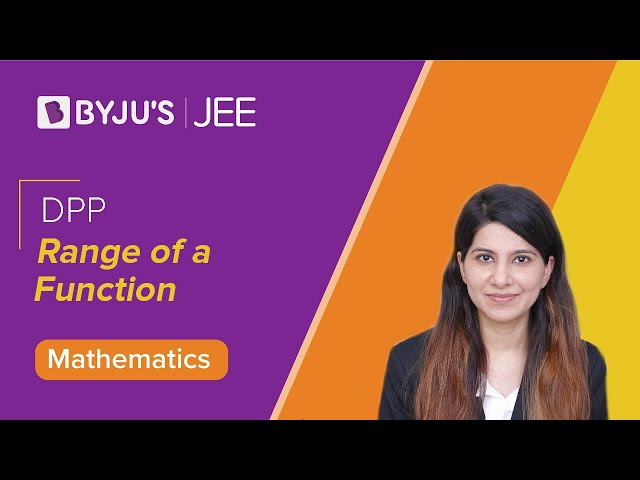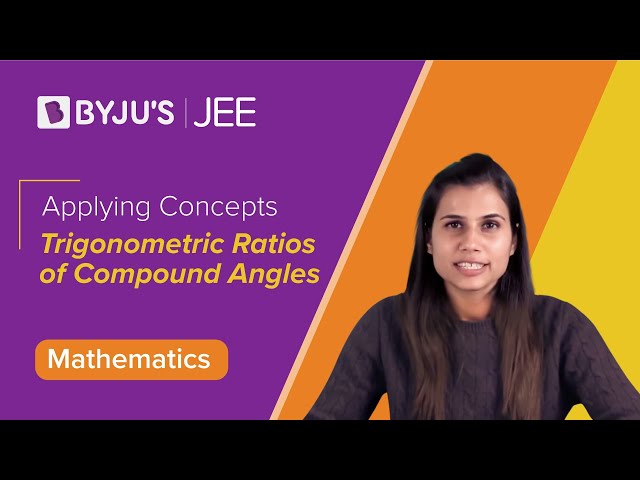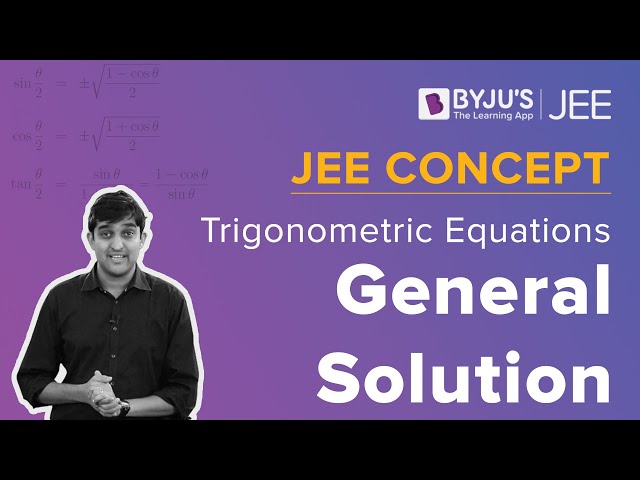JEE Main 2020 Maths Paper With Solutions Shift 1 September 5
1. If the volume of a parallelopiped, whose coterminuous edges are given by the vectors
a)
b)
c) n = 9
d) n = 7
(12+n2)-(6+n)+n(2n-4) = 158
3n2-5n+6-158 = 0
3n2-5n-152 = 0
3n2-24n+19n-152 = 0
(3n+19)(n-8) = 0
⇒ n = 8
⇒
Answer: b
2. A survey shows that 73% of the persons working in an office like coffee, whereas 65% like tea. If x denotes the percentage of them, who like both coffee and tea, then x cannot be:
a) 63
b) 54
c) 38
d) 36
C → Coffee and T → Tea
n(C) = 73, n(T) = 65
n(coffee) = 73/100
n(tea) = 65/100
n(T∩C) = x/100
n(C∪T) = n(C)+n(T)-x
= 73+65-x
⇒ x
⇒ 73-x
⇒ x
⇒ 65-x
⇒ x
38
x = 36
x
Answer: d
3. The mean and variance of 7 observations are 8 and 16, respectively. If five observations are 2,4,10,12,14, then the absolute difference of the remaining two observations is:
a) 1
b) 4
c) 3
d) 2
Var(x) =
16 = (x12+ x22+ x42+ x52+ x62+ x72)/7 -64
80×7 = x12+ x22+ x32+…+ x72
Now, x62+ x72 = 560-(x12+…x52)
x62+x72 = 560-(4+16+100+144+196)
x62+x72 = 100 ..(i)
Now, (x1+x2+…+x7)/7 = 8
x6+x7 = 14
from (i) and (ii)
(x6+x7)2-2x6x7 = 100
2x6x7 = 96
⇒ x6x7 = 48 ..(iii)
Now, |x6-x7| = √((x6+x7)2-4x6x7)
= √(196-192)
= 2
Answer: d
4. If 210+29×31+28×32+…..+2×39+310 = S-211, then S is equal to:
a) 311
b) (311/2)+210
c) 2×311
d) 311-212
Let S’ = 210+29×31+ 28×32+—–+2×39+310 ..(i)
3×S’/2 = 29×31+28×32+…+310+311/2 ..(ii)
Equation (i) – (ii)
-S’/2 = 210-311/2
S’ = 311-211
Now S’= S-211
S = 311
Answer: a
5. If 32 sin2α-1,14 and 34-2 sin2α are the first three terms of an A.P. for some α , then the sixth term of this A.P. is:
a) 65
b) 81
c) 78
d) 66
28 = 32sin2α-1+34-2 sin2α
28 = 9sin2α/3 + 81/9sin2α
Let 9sin2α = t
28 = (t/3)+(81/t)
t2-84t+243 = 0
t2-81t-3t+243 = 0
t(t -81)-3(t-81) = 0
(t -81)(t-3) = 0
t = 81, 3
9sin2α = 92 or 3
sin2α = 1/2, 2 (rejected)
First term, a = 32sin2α-1
a = 1
Second term = 14
Common difference, d = 13
T6 = a+5d
T6 = 1+5×13 = 66
Answer: d
6. If the common tangent to the parabolas, y2 = 4x and x2 = 4y also touches the circle, x2+y2 = c2, then c is equal to:
a) 1/2
b) 1/4
c) 1/√2
d) 1/2√2
y = mx+1/m
x2 = 4(mx+1/m)
x2 -4mx-4/m = 0
D = 0
16m2+16/m = 0
16(m3+1)/m = 0
m = -1
⇒ y+x = -1
Now, |-1/√2| = |c|
c =
Answer: c
7. If the minimum and the maximum values of the function f: [π/4, π/2] → R defined by f(θ) =
a) (0,4)
b) (-4,0)
c) (-4,4)
d) (0,2√2)
f(θ) =
C1 → C1-C2
C3 → C3+C2
=
C2 → C2-C3
=
= 1(2cos2 θ-8)+(8+2cos2 θ) -4sin2θ
f(θ) = 4cos 2θ
Answer: b
8. Let λ∈R. the system of linear equations
2x1-4x2+λx3 = 1
x1-6x2+x3 = 2
λx1-10x2+4x3 = 3
is inconsistent for:
a) exactly two values of λ
b) exactly one negative value of λ.
c) every value of λ.
d) exactly one positive value of λ.
D =
= 2(3λ+ 2)( λ-3)
D1 = -2(λ-3)
D2 = -2(λ+1)( λ-3)
D3 = –2(λ-3)
When λ = 3, then
D = D1 = D2 = D3 = 0
⇒ Infinite many solution
When λ = –2/3 then D1, D2, D3 none of them is zero so equations are inconsistent
λ = –2/3
Answer: b
9. If the point P on the curve, 4x2+5y2 = 20 is farthest from the point Q(0, -4), then PQ2 is equal to:
a) 48
b) 29
c) 21
d) 36
Given ellipse is (x2/5)+(y2/4) = 1
Let point P is (√5 cos θ, 2 sin θ)
(PQ)2 = 5cos2 θ+ 4(sin θ + 2)2
(PQ)2 = cos2θ+ 16 sin θ + 20
(PQ)2 = -sin2θ+ 16 sin θ + 21
= 85 -(sin θ – 8)2
Will be maximum when sin θ = 1
(PQ)2max = 85-49 = 36
Answer: d
10. The product of the roots of the equation 9x2-18|x|+5 = 0 is :
a) 25/81
b) 5/9
c) 5/27
d) 25/9
Let |x| = t
9t2-18t +5 = 0
9t2 -15t -3t+5 = 0
(3t -5)(3t-1) = 0
|x| = 5/3, 1/3
⇒ x = 5/3, -5/3, 1/3, -1/3
⇒ Product = 25/81
Answer: a
11. If y = y(x) is the solution of the differential equation ((5+ex)/(2+y))(dy/dx)+ex = 0 satisfying y(0) = 1, then a value of y(loge13) is:
a) 1
b) 0
c) 2
d) -1
((5+ex)/(2+y))(dy/dx) = -ex
∫dy/(2+y) = ∫-e-x/(ex+5) dx
ln (y+2) = -ln(ex+5) + C
(y+2) (ex+5) = C
Since y(0) = 1
⇒ C = 18
y+2 = 18/ex+5
at x = ln 13
y+2 = 18/(13+5) = 1
y = -1
Answer: d
12. If S is the sum of the first 10 terms of the series tan-1(1/3) + tan-1(1/7) + tan-1(1/13) + tan-1(1/21) +…, then tan(S) is equal to:
a) 5/11
b) 5/6
c) -6/5
d) 10/11
S =
Tr =
Tr = tan-1(r+1)-tan-1r
T1 = tan-12-tan-11
T2 = tan-13-tan-12
T3 = tan-14-tan-13
T10 = tan-111-tan-110
S = (tan-12-tan-11) + (tan-1 3-tan-12) + (tan-14-tan-13) + ……… + (tan-1 11-tan-110)
S = tan-111-tan-11
= tan-1 [(11-1)/(1+11)]
⇒ tan S = 10/12
= 5/6
Answer: b
13. The value of
a) π/2
b) π/4
c) π
d) 3π/2
I =
=
⇒ 2I = π
I = π/2
Answer: a
14. If (a, b, c) is the image of the point (1,2,-3) in the line, (x+1)/2 = (y-3)/-2 = z/-1 then a+b+c is:
a) 2
b) 3
c) -1
d) 1

Vector PM and (
⇒ (2λ-2)2+(1-2λ)(-2)+(3-λ) (-1) = 0
⇒ 4λ-4+4 λ-2+λ-3 = 0
⇒ 9λ = 9
⇒ λ = 1
⇒ M(1,1,-1)
Now, P’ = 2M-P
= 2(1,1,-1)-(1, 2, -3)
= (1, 0, 1)
a+b+c = 2
Answer: a
15. If the function 
is twice differentiable, then the ordered pair (k1, k2) is equal to:
a) (1,1)
b) (1,0)
c) (1/2, -1)
d) (1/2, 1)
f(x) is continuous and differentiable
f(π–) = f(π) = f(π+)
-1 = -k2
⇒ k2 = 1

f'(π–) = f’(π+)
⇒ 0 = 0
So differentiable at x = 0

f’’(π–) = f’’(π+)
2k1 = k2
k1 = 1/2
Answer: d
16. If the four complex numbers z,
a) 2
b) 4
c) 4√2
d) 2√2

Let z = x+iy
CA2 = AB2+BC2
22x2+22y2 = 32
x2+y2 = 8
√(x2+y2 ) = 2√2
Answer: d
17.If where c is a constant of integration, then g(0) is equal to :
where c is a constant of integration, then g(0) is equal to :
a) 2
b) e
c) 1
d) e2

⇒ g(0) = 2
Answer: a
18. The negation of the Boolean expression x ↔ y is equivalent to:
a) (x˄y) ˄(∼x˅∼y)
b) (x˄y) ˅ (∼x˄∼y)
c) (x˄∼y) ˅ (∼x˄∼y)
d) (∼x˄y) ˅ (∼x˄∼y)
As we know
p ↔ q = (p→ q) ˄ (q → p)
∼(p ↔ q) = (p˄∼q) ˅ (∼p˄q)
⇒ so, ∼(x ↔ ∼y) = (x˄y) ˅ (∼x˄∼y)
Answer: b
19. If α is positive root of the equation, p(x) = x2-x-2 = 0, then
a) 1/2
b) 3/√2
c) 3/2
d) 1/√2

Answer: b
20. If the co-ordinates of two points A and B are (√7, 0) and (-√7, 0) respectively and P is any point on the conic, 9x2+16y2 = 144, then PA+PB is equal to :
a) 6
b) 16
c) 9
d) 8
(x2/16)+(y2/9) = 1
e = √(1-9/16)
= √7/4
F1(√7, 0), F2(-√7, 0)
PF1+PF2 = 2a
PA+PB = 2×4 = 8
Answer: d
21. The natural number m, for which the coefficient of x in the binomial expansion of (xm+1/x2)22 is 1540 is..
Tr+1 = 22Cr (xm)22-r(1/x2)r
= 22Cr (x)22m-mr-2r
Given 22Cr = 1540 = 22C19
⇒ r = 19
Since 22m-rm-2r = 1
⇒ m = (2r+1)/(22-r)
m = 13 (At r = 19)
Answer: 13
22. Four fair dice are thrown independently 27 times. Then the expected number of times, at least two dice show up a three or a five, is
P(at 2, 3 or 4) = 4C2 (2/6)2(4/6)2+ 4C3 (2/6)3(4/6)1+ 4C4 (2/6)4
= 6×(1/9)×(4/9)+4×(1/27)×(2/3)+(1/81)
= 33/81
= 11/27
⇒ nP ⇒11
Answer: 11
23. Let f(x) = x[x/2], for -10<x<10, where [t] denotes the greatest integer function. Then the number of points of discontinuity of f is equal to
f(x) = x[x/2]
x∈ (-10, 10)
x/2 ∈(-5,5) → 9 integers
Check continuity at x = 0
f(0) = 0
f(0+) = 0
f(0–) = 0
continuous at x = 0.
Function will be discontinuous when
x/2 =
-4, -3, -2, -1, 0, 1, 2, 3, 4
8 points of discontinuity
Answer: 8
24. The number of words, with or without meaning, that can be formed by taking 4 letters at a time from the letters of the word ’SYLLABUS’ such that two letters are distinct and two letters are alike, is
SS, Y, LL, A, B, U
ABCC type words

Answer: 240
25. If the line, 2x-y+3 = 0 is at a distance 1/√5 and 2/√5 from the lines 4x-2y+α = 0 and 6x-3y+β = 0, respectively, then the sum of all possible values of α and β is
L1 : 2x-y+3 = 0
L2 : 4x-2y+α = 0
L3 : 6x-3y+β = 0
|(α/2)-3|/√5 = 1/√5
⇒ (α/2)-3 = 1, -1
⇒ α = 8, 4
|(β/3)-3|/√5 = 2/√5
⇒ (β/3)-3 = 2, -2
⇒ β = 15, 3
sum of all possible values of α and β = 8+4+15+3 = 30
Answer: 30
Video Lessons – September 5 Shift 1 Maths




Comments